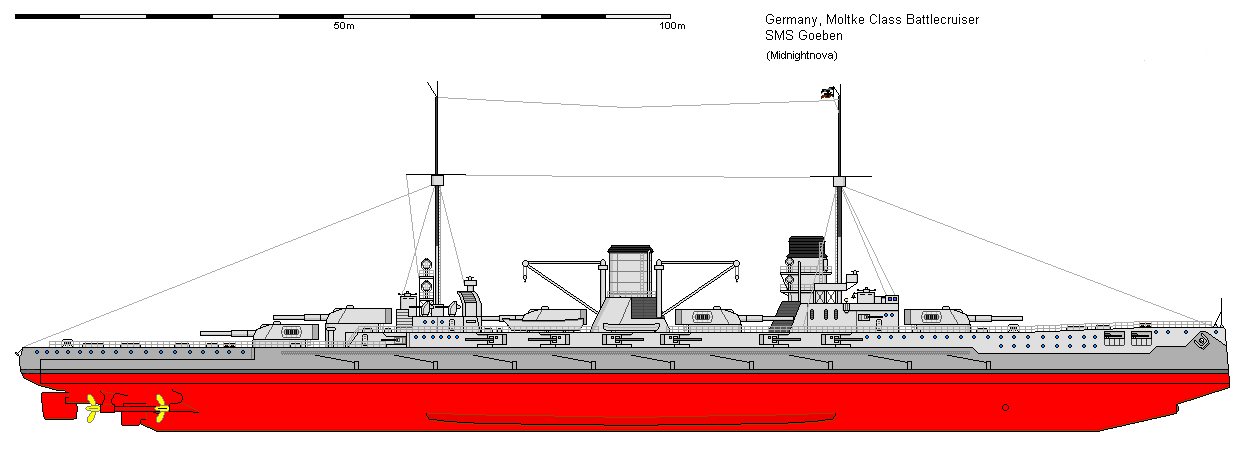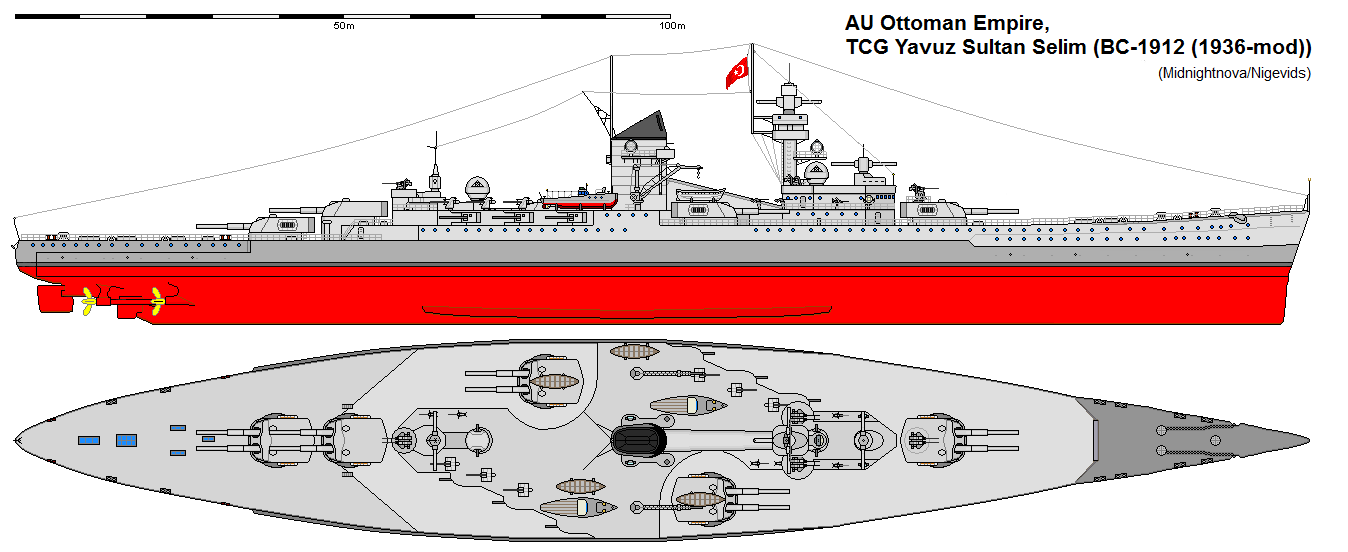
TCG Yavuz Sultan Selim (BC-1912 (1936-mod))
The Yavuz arrived in Turkish waters in August of 1914 as the SMS Goeben. Presented to the Ottoman Empire as a gift from the Germanic States Empire (and to avoid neutrality problems) the ship was renamed Yavuz Sultan Selim while the German Admiral in command was offered the post as Commander-in-Chief of the Turkish Navy. The "Flight of the Goeben" (see Wiki SMS Goeben) is one of the more interesting stories of World War One, with the ship evading French and British warships as the Goeben, accompanied by the Breslau, sailed from the Western Mediterranean to Istanbul. The now Yavuz had the most active career of any Capital Ship in WW1. From fighting Russian battleships in the Black Sea to attacking British shipping from out of the Dardanelles. Cumulative damage to the ship from gunfire and mines took great toll on the ship and it was barely seaworthy by the end of 1918.

With the Russian Revolution, and the advance of the Bolsheviks on the Black Sea ports, it was felt by the Allied Powers that Turkey (who hated the Russians anyway) required an effective ship to counter the Russian Black Sea fleet ships. To that end the crew of the Yavuz was transferred to Scapa Flow where they took command of the ex-Germanic States battlecruiser Moltke. The Moltke was chosen as the ship would be instantly familiar being the sistership of the Yavuz. The newly renamed Kanuni Sultan Suleiman arrived in Turkish waters at the end of 1919. Sailing neutrality patrols in the Black Sea during 1919-21. The removal of the Russian Black Sea Fleet by General Wrangel made these patrols superfluous, however the Turks retained the ship while Yavuz was being repaired and was formally purchased from the Allied War Reparations Commission in 1924. This gave the Turks two very capable battlecruisers to guard the Dardanelles with.

The Yavuz had been repaired as far as it was possible to do so with the limited resources of the Turkish port facilities. While seaworthy, the ship was only operating at about 80% of its capabilities. This state of affairs remained till 1933 when funds were made available to send the ship off to Germany for a badly needed rebuilding. The Germanic States, courting allies, made sure that the cost to the Ottoman Empire was only about 60% of the actual value of the work done. The Germanic States showed the Turkish Navy the plans of the upgrade to the battlecruiser Seydlitz (which was of the same layout as the Yavuz) but the Turks turned this down as they had no need of long range raider vessels. The Turks wished to retain as large a broadside as possible while improving the secondary and later anti-aircraft armaments. Improved fire control systems were also to be upgraded. The wing turret system while workable did cause strain on the decks when the 'offside' turret was fired across the deck through the blast effects. Other problems identified with these ships were the mounting of the 5.9" guns at main deck level which became useless in any sort of seaway and the 'plunging' of the bow in the same sort of seaway which made fire control difficult. The rebuilding (as shown above) removed the bow and forward submerged torpedo tube allowed for a new bow section to be fitted which with the added buoyancy stopped the plunging and allowed the ship to maintain speeds in heavier seaways than possible previously. The removal of the main deck 5.9" and their plating over gave the hull a much more streamlined effect. Half of the 5.9" guns were resited one deck up in new casemate mountings as the Turks wished to keep an anti-torpedoboat capability. Sited above these weapons were the heavy anti-aircraft guns, six single 88mm guns. Four twin 37mm and six single 20mm guns were fitted for the light AA armament. Other alterations included the change from coal fired to oil fired boilers, the rebuilding of the superstructures to take the new fire control gear and new weaponry placements, and not least the trunking of the funnels together into a new funnel arrangement. The return of the Yavuz in 1936 allowed the Kanuni to be sent to Germany for its refit from whence it returned in late 1938. The only difference between the two ships rebuilding being the fitting of four twin 4.1" turrets in place of the six single 88mm guns. Both ships from 1940 onwards received many extra twin and single 20mm AA guns and eventually the twin 37mm were replaced with twin 40mm of a much newer model.
| Displacement | 24,700 tons std 27,450 tons full load |
| Length | 612 ft (orig) 647ft (after rebuilding) |
| Breadth | 98.5 ft |
| Draught | 30 ft |
| Machinery | 4 shaft steam turbines, 86,000shp |
| Speed | 28.5 knots |
| Range | 5000 miles at 18 knots (1800 at 25 knots) |
| Armour | 11" Side armour, 3.9" deck armour, 9.1" turrets |
| Armament | 10 x 11" (5x2) 6 x 5.9" (6x1) 6 x 88mm (6x1) 8 x 37mm (4x2) 6 x 20mm (6x1) |
| Complement | 1200 |
| Notes | TCG Yavuz Sultan Selim (ex-SMS Goeben) TCG Kanuni Sultan Suleiman (ex-SMS Moltke) |
Left: Yavuz under repair at Istanbul 1918-20. Right: Yavuz stops at Malta on its
way to Germany in 1932.